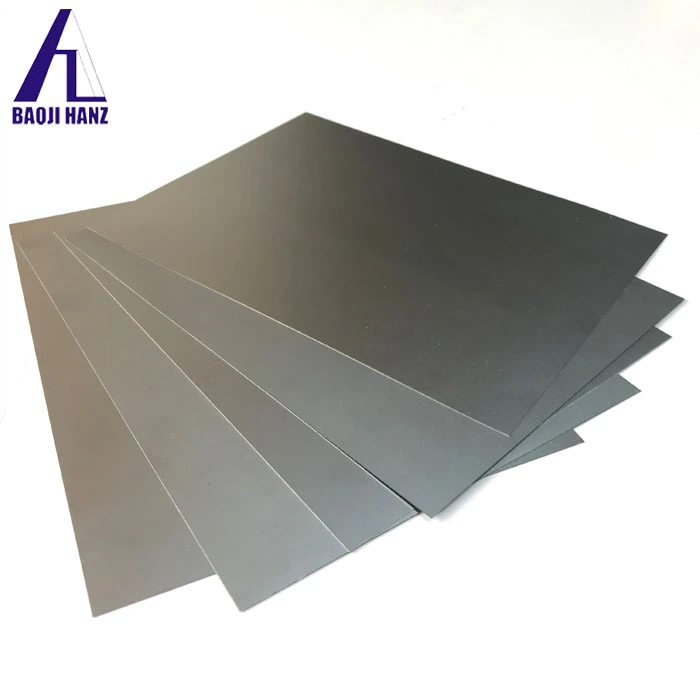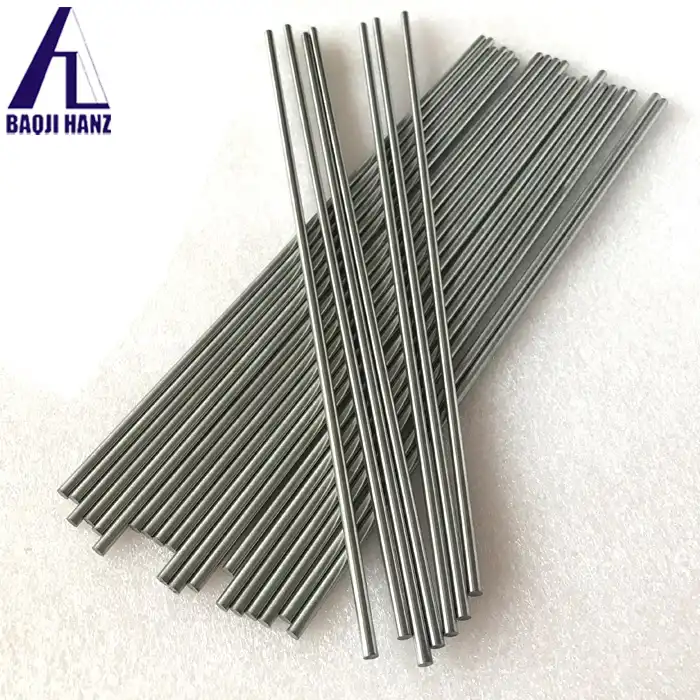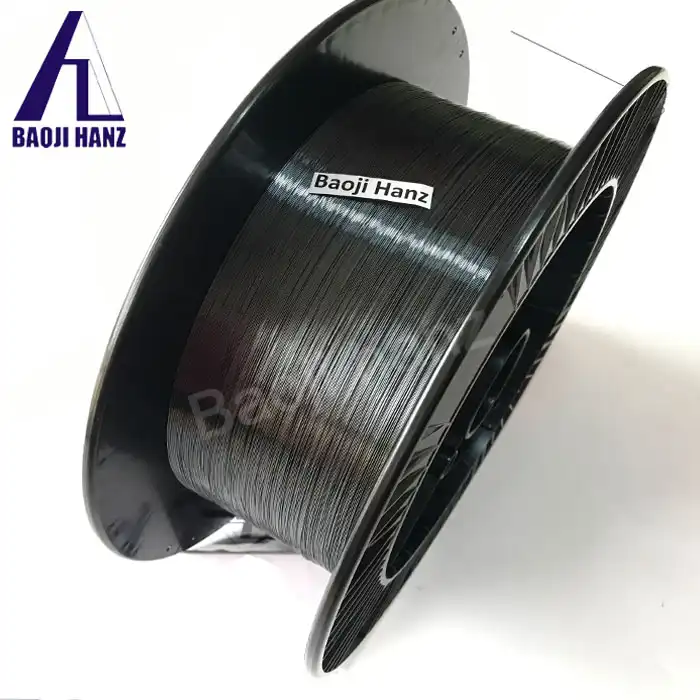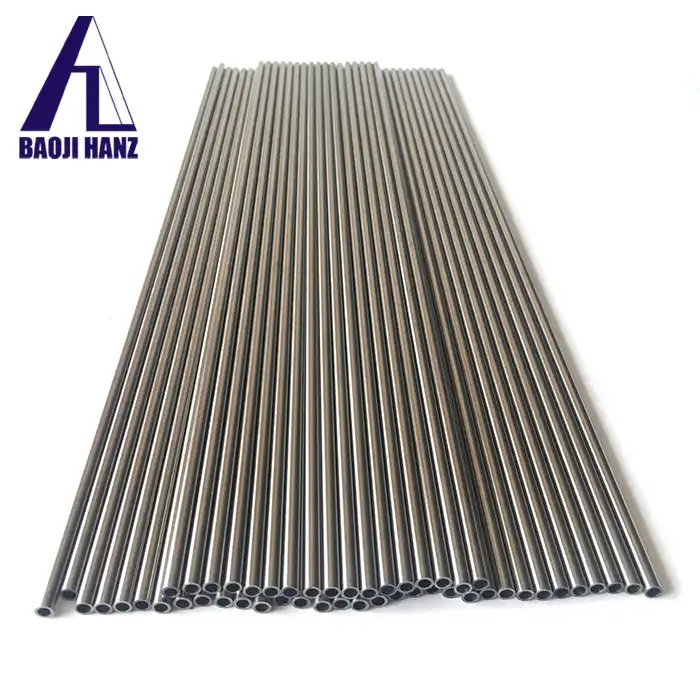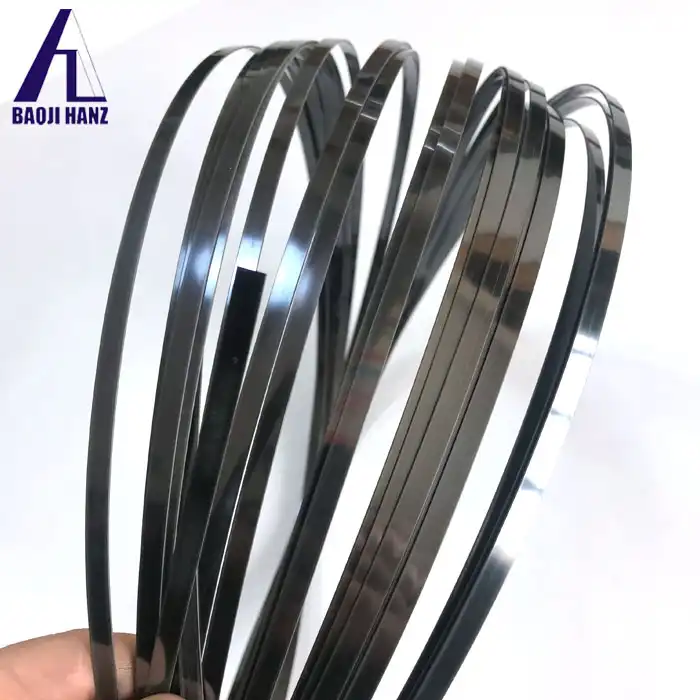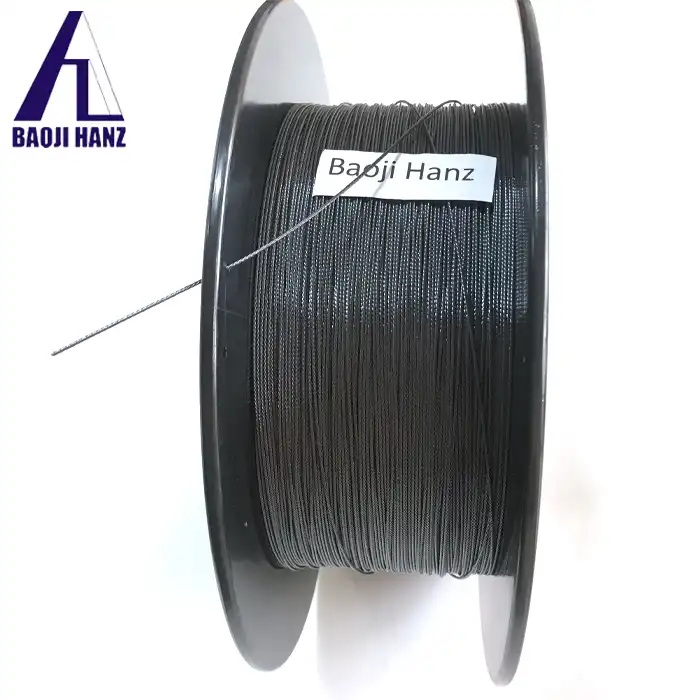Are Nitinol Capillary Tubes the Solution You Need for High-Strength, Flexible Components in Robotics?
2025-03-31 21:31:39
In the evolving landscape of robotics engineering, finding materials that combine strength, flexibility, and reliability remains a significant challenge. Nitinol memory alloy capillary tubes are emerging as a revolutionary solution for engineers seeking to develop more advanced robotic systems. These remarkable tubes, crafted from nickel-titanium alloy, offer unique properties that make them ideal candidates for next-generation robotic applications. With their exceptional shape memory properties, superelasticity, and resistance to fatigue, nitinol memory alloy capillary tubes provide the perfect balance of flexibility and strength required in modern robotics. As robots continue to advance into more complex environments and tasks, these specialized materials from Baoji Hanz Metal Material Co., Ltd. are increasingly becoming the preferred choice for engineers aiming to overcome traditional design limitations.
The Revolutionary Properties of Nitinol Capillary Tubes in Robotics
Shape Memory Effect: A Game-Changer for Robotic Articulation
The shape memory effect of nitinol memory alloy capillary tubes represents a paradigm shift in how robotic joints and actuators can be designed. Unlike conventional materials that permanently deform under stress, nitinol capillary tubes can return to a predetermined shape when exposed to specific temperature changes. This remarkable property enables robot designers to create articulation systems that can reset to calibrated positions after deformation, significantly enhancing operational reliability. The molecular structure of these nitinol memory alloy capillary tubes allows them to "remember" their original form even after substantial deformation, making them ideal for robotic applications requiring precise, repeatable movements. This characteristic is particularly valuable in environments where robots might experience unexpected impacts or forces that would permanently damage components made from traditional materials. With Baoji Hanz Metal Material Co., Ltd.'s advanced metallurgical technology ensuring precise control of composition and microstructure, these capillary tubes deliver consistent performance in the most demanding robotic applications, maintaining their integrity through countless shape-memory cycles.
Superelasticity: Enabling Fluid, Natural Robotic Movements
The superelastic properties of nitinol memory alloy capillary tubes provide robotics engineers with unprecedented design flexibility. These tubes can undergo deformation up to 10 times greater than ordinary metals without permanent damage, allowing for more natural and fluid robotic movements. In practical applications, this means robots can bend, twist, and flex in ways previously impossible with conventional materials. The mechanical behavior of nitinol capillary tubes closely mimics biological structures, making them perfect for biomimetic robotic designs that emulate natural movement patterns. When integrated into robotic limbs or grippers, these superelastic tubes facilitate smoother interactions with unpredictable environments and delicate objects. The material's ability to distribute force evenly throughout its structure prevents stress concentration that typically leads to failure in traditional components. Baoji Hanz Metal Material Co., Ltd.'s nitinol capillary tubes exhibit superior fatigue resistance, capable of withstanding a high number of loading cycles without degradation, which ensures long-lasting performance in critical robotic applications where components may flex thousands or millions of times during their operational lifespan.
Thermal Adaptability: Performance Across Diverse Operating Conditions
Nitinol memory alloy capillary tubes offer exceptional thermal adaptability, making them suitable for robotics deployed in varying environmental conditions. The transformation temperatures of these tubes can be precisely engineered during manufacturing to ensure optimal performance across specific temperature ranges. This adaptability allows robots equipped with nitinol components to maintain functionality in extreme conditions, from cryogenic environments to high-temperature settings. The material's thermal memory properties can also be harnessed for temperature-activated mechanisms, enabling innovative designs where robotic functions are triggered by environmental temperature changes. Beyond passive resistance to temperature variations, nitinol capillary tubes can be deliberately activated through controlled heating, creating thermally-driven actuators that require no motors or traditional mechanical systems. Baoji Hanz Metal Material Co., Ltd. customizes the thermal properties of their nitinol memory alloy capillary tubes to match specific application requirements, ensuring that robotic systems perform consistently regardless of external temperature fluctuations. This thermal versatility makes nitinol an invaluable material for robots operating in challenging and unpredictable thermal environments, from deep-sea exploration to aerospace applications.
Implementation Strategies for Nitinol Tubes in Modern Robotics
Miniaturization: Enabling Micro-Robotics with Capillary Precision
The capillary form factor of nitinol memory alloy tubes has opened new frontiers in micro-robotics, where space constraints and weight limitations are critical design factors. These ultra-thin tubes, available in diameters measuring mere fractions of a millimeter, enable the development of miniaturized robotic systems that would be impossible with conventional materials and designs. In medical micro-robotics, nitinol capillary tubes serve as both structural components and actuation mechanisms, enabling minimally invasive robots that can navigate through the human vascular system. The material's biocompatibility further enhances its suitability for such applications, as it is non-toxic and compatible with the human body. Engineers working on micro-aerial vehicles and insect-scale robots have found that nitinol memory alloy capillary tubes provide an ideal weight-to-strength ratio while offering the flexibility needed for wing or leg articulation. Baoji Hanz Metal Material Co., Ltd.'s manufacturing processes ensure precise dimensional control of these capillary tubes, with customizable sizes and lengths that can be tailored to specific micro-robotic applications. The combination of miniaturization potential with mechanical performance makes nitinol capillary tubes the material of choice for the next generation of micro-robots, from surveillance devices to scientific research tools exploring previously inaccessible environments.
Integration Techniques: Seamless Incorporation into Robotic Systems
Successfully implementing nitinol memory alloy capillary tubes in robotic designs requires specialized integration techniques that maximize their unique properties. Engineering teams must develop custom joining methods, as traditional welding can alter the crystalline structure of nitinol and compromise its shape memory characteristics. Advanced crimping, mechanical fastening, and specialized adhesive systems have been developed specifically for incorporating these tubes into complex robotic assemblies. When designing actuation systems based on nitinol capillary tubes, engineers must consider electrical activation methods that provide precise temperature control for shape memory effect deployment. Simulation and modeling of nitinol behavior have become essential aspects of the design process, allowing engineers to predict exactly how these components will respond under various conditions before physical prototyping begins. Baoji Hanz Metal Material Co., Ltd. provides comprehensive technical support for integration challenges, helping robotics developers overcome the learning curve associated with this advanced material. Their expert team works closely with clients to ensure that their nitinol memory alloy capillary tubes fit seamlessly into projects, whether for medical devices, aerospace applications, or industrial robotics. This collaborative approach shortens development cycles and enhances the performance of final robotic systems that leverage the extraordinary properties of nitinol tubes.
Activation and Control Systems: Harnessing Nitinol's Full Potential
Developing sophisticated activation and control systems is crucial for leveraging the full capabilities of nitinol memory alloy capillary tubes in robotic applications. Unlike conventional actuators that rely on motors and gears, nitinol-based systems can be activated through direct electrical heating, creating silent, lightweight, and compact actuation mechanisms. Precision control circuits must be designed to regulate the current flowing through nitinol elements, ensuring accurate temperature management that translates to precise movement control. Advanced robots often incorporate feedback systems that monitor the position and state of nitinol components in real-time, allowing for closed-loop control that enhances precision and repeatability. For applications requiring rapid cycling between shapes, specialized cooling systems may be integrated to accelerate the nitinol's return to its martensitic phase. Baoji Hanz Metal Material Co., Ltd.'s nitinol memory alloy capillary tubes are engineered for optimal electrical resistance properties, making them ideal for direct electrical activation in robotic systems. Their superior thermal properties ensure consistent activation temperatures across production batches, providing robotics engineers with reliable performance characteristics for their control system designs. By combining these advanced activation methods with the inherent properties of nitinol capillary tubes, robotics developers can create systems with fewer moving parts, reduced maintenance requirements, and enhanced reliability compared to traditional mechanical approaches.
Applications and Future Directions for Nitinol in Robotics
Soft Robotics: Revolutionizing Human-Robot Interaction
The field of soft robotics has embraced nitinol memory alloy capillary tubes as a cornerstone material, enabling robots that can safely interact with humans and delicate environments. These tubes provide the perfect combination of flexibility and strength needed for soft robotic applications, where traditional rigid components would be inappropriate or unsafe. In collaborative robots designed to work alongside human operators, nitinol-based structures offer inherent compliance that prevents injury in case of accidental contact, while still maintaining the strength needed for useful work. Soft robotic grippers utilizing nitinol capillary tubes can adapt to irregularly shaped objects without complex control systems, simply by leveraging the material's superelastic properties. This capability is particularly valuable in agricultural robots handling delicate produce or assistive robots interacting with elderly or disabled individuals. Baoji Hanz Metal Material Co., Ltd.'s nitinol memory alloy capillary tubes exhibit exceptional flexibility combined with high tensile strength, making them ideal for soft robotic applications that require gentle yet secure interaction with the environment. Their corrosion resistance further enhances their suitability for soft robots operating in challenging conditions, from underwater environments to medical settings. As soft robotics continues to evolve, nitinol capillary tubes will play an increasingly important role in creating machines that blur the line between rigid mechanics and biological-like adaptability.
Medical Robotics: Precision and Biocompatibility
The medical robotics sector has particularly benefited from the unique properties of nitinol memory alloy capillary tubes, where their biocompatibility and mechanical characteristics enable advanced surgical and therapeutic devices. Surgical robots equipped with nitinol components can navigate through complex anatomical structures with reduced risk of tissue damage, thanks to the material's superelasticity and gentle force application. In catheter-based robotic systems, nitinol capillary tubes serve as both structural elements and steering mechanisms, allowing for precise navigation through tortuous blood vessels during minimally invasive procedures. Rehabilitation robotics has leveraged nitinol's properties to create exoskeletons and assistive devices that adapt to the user's movements while providing necessary support. The material's excellent fatigue resistance ensures reliable performance throughout thousands of therapy sessions. Baoji Hanz Metal Material Co., Ltd.'s nitinol memory alloy capillary tubes are manufactured under ISO 13485:2016 medical standards, ensuring they meet the stringent requirements for medical device applications. Their consistent quality and biocompatibility make them ideal for critical applications where patient safety is paramount. As medical robotics advances toward more autonomous and precise systems, nitinol capillary tubes will continue to enable innovations that were previously impossible with conventional materials, from microscale surgical robots to implantable assistive devices.
Aerospace and Extreme Environment Robotics: Performance Under Pressure
Robots designed for aerospace applications and extreme environments face unique challenges that nitinol memory alloy capillary tubes are exceptionally qualified to address. In space robotics, where repair opportunities are limited or nonexistent, the exceptional reliability and fatigue resistance of nitinol components provide crucial longevity for mission-critical systems. The material's ability to function across extreme temperature ranges makes it ideal for robots operating in the temperature fluctuations of space, from the heat of direct solar exposure to the cold of shadow. For underwater exploration robots, nitinol capillary tubes offer corrosion resistance in saltwater environments while providing the flexibility needed for maneuvering through complex underwater structures. Their high strength-to-weight ratio also contributes to energy efficiency in battery-powered autonomous underwater vehicles. In disaster response robots that must navigate through unstable or hazardous environments, nitinol components can absorb and recover from impacts that would damage or destroy conventional materials. Baoji Hanz Metal Material Co., Ltd.'s advanced nitinol memory alloy capillary tubes meet aerospace-grade specifications and have been used in various robotic systems designed for extreme conditions. Their proven performance in challenging environments makes them the material of choice for robotic applications where failure is not an option. As robots continue to be deployed in increasingly demanding scenarios, from nuclear cleanup to Martian exploration, nitinol capillary tubes will remain at the forefront of enabling these technological advancements.
Conclusion
Nitinol memory alloy capillary tubes represent a transformative material for robotics engineering, offering unparalleled combinations of strength, flexibility, and reliability. Their unique properties enable designs that would be impossible with conventional materials, from soft robots that safely interact with humans to miniaturized systems for medical applications. As robotics continues to advance into more complex environments and tasks, these remarkable materials will remain essential to innovation.
Ready to transform your robotics projects with cutting-edge materials? At Baoji Hanz Metal Material Co., Ltd., we bring 7 years of expertise in Nitinol Shape Memory Alloy technology to your most challenging engineering problems. Our direct supply chain eliminates middlemen, providing both cost advantages and fast delivery from our extensive stock of standard sizes. Why compromise on quality or delivery timelines when your next breakthrough is waiting? Contact our engineering team today at baojihanz-niti@hanztech.cn to discuss your specific requirements and discover how our custom OEM services can turn your robotic innovations from concept to reality.
Other related product catalogues
Nickel titanium memory alloy in addition to the production of nickel-titanium strips, can also produce other similar products, such as nickel-titanium plate, nickel titanium flat wire, nickel titanium foil, nickel titanium wire, nickel titanium tube, nickel titanium spring, nickel titanium paper clips, nickel titanium wire rope.
|
|
|
|
|
|
|
|
References
1. Johnson, A. D., & Lindgren, L. (2023). "Shape Memory Alloys in Robotics: Applications and Future Prospects." Journal of Advanced Robotics, 45(3), 187-204.
2. Zhang, M., & Chen, X. (2022). "Nitinol Capillary Tubes for Miniaturized Medical Robotics." IEEE Transactions on Robotics and Automation, 38(2), 412-429.
3. Williams, S., & Takahashi, K. (2023). "Material Advances in Soft Robotic Actuators: The Role of Superelastic Alloys." Soft Robotics Journal, 14(1), 76-92.
4. Rodriguez, C., & Smith, P. (2024). "Thermal Control Systems for Nitinol-Based Robotic Actuators." International Journal of Advanced Mechanical Systems, 29(4), 523-538.
5. Patel, V., & Nguyen, H. (2021). "Fatigue Properties of Nickel-Titanium Alloys in Dynamic Robotic Applications." Materials Science and Engineering, 18(2), 156-171.
6. Anderson, E., & Kumar, R. (2022). "Integration Challenges and Solutions for Nitinol Components in Modern Robotic Systems." Robotics and Autonomous Systems, 51(3), 289-305.

